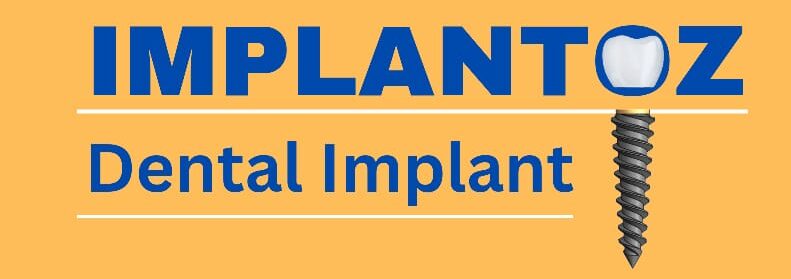At IMPLANTOZ, patient safety is our first priority. Our unwavering commitment to strict sterilization protocols predates the COVID-19 pandemic. We follow strict WHO and OSHA Guidelines and make sure our entire dental facility is sterilized round the clock.
Rigorous Four-Step Sterilization Process:
After every patient, we execute a meticulous four-step sterilization process, guaranteeing that all instruments are not only sanitized but reach the 100% sterilized standard.
- Thorough Cleaning: Eliminating debris and contaminants.
- Ultrasonic Disinfection: Deep disinfection with advanced technology.
- Chemical Sterilization: Employing cutting-edge methods for microbe elimination.
- Steam Sterilization: Finalizing the process with high-temperature steam.
Dental Instrument Sterilization for Patient Safety:
Dental sterilization is a critical aspect of infection control in dental practices. It involves the use of various processes to ensure that dental instruments and equipment are free from microorganisms. Here’s an overview of common sterilization processes used in dental settings:
1. Autoclave Sterilization
At IMPLANTOZ, we prioritize your safety through advanced sterilization techniques, and a crucial component of our rigorous sterilization process is the use of a Steam Autoclave.
How It Works:
Our Steam Autoclave utilizes high-pressure steam to eliminate bacteria, viruses, and other microorganisms from dental instruments. This method is highly effective and is widely recognized for its ability to achieve surgical-level sterility.
Key Features:
- High-Temperature Steam: The autoclave exposes instruments to high-temperature steam, reaching levels that effectively destroy even the most resilient pathogens.
- Pressure Control: The autoclave ensures proper pressure levels, which is crucial for achieving the desired sterilization results.
- Thorough Sterilization: From handpieces to surgical instruments, every item is meticulously sterilized to meet and exceed industry standards.
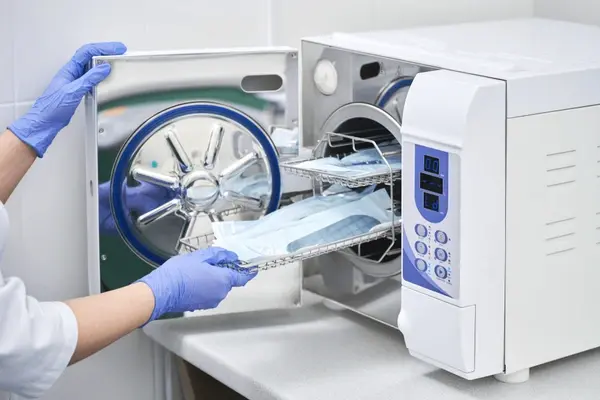
2. Ultraviolet (UV) Sterilizer
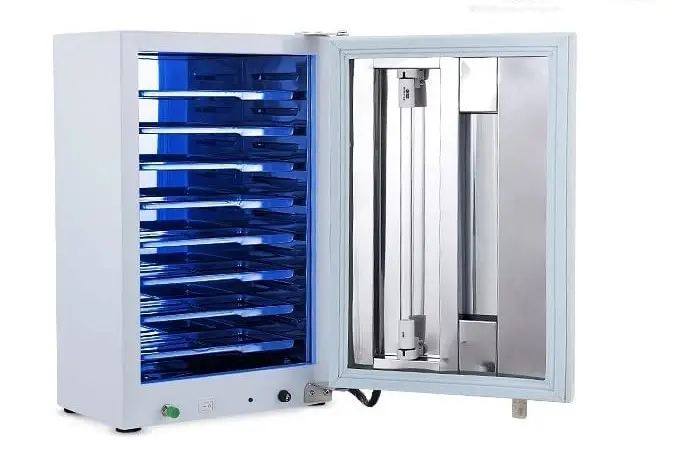
Our Advanced Dental UV Chamber utilizes ultraviolet (UV) light to disinfect and sterilize dental instruments effectively. This method has proven to be a powerful and efficient means of eliminating bacteria, viruses, and other pathogens.
Key Features of Our Dental UV Chamber:
- UV-C Light Technology: The chamber harnesses the power of UV-C light and breaks down the DNA and RNA of microorganisms, rendering them inactive.
- Non-Toxic and Chemical-Free: UV sterilization is entirely non-toxic and chemical-free, providing an environmentally friendly and safe alternative to traditional methods.
- Comprehensive Sterilization: From dental instruments to equipment surfaces, the Dental UV Chamber ensures a thorough and complete sterilization process.
3. Cold Sterilization (Liquid Chemical Sterilization):
Cold sterilization, also known as chemical sterilization is used in dental practices to disinfect heat-sensitive instruments. This process involves the use of liquid chemical agents to achieve sterilization.
Advantages:
- Suitable for Heat-Sensitive Items: Ideal for instruments susceptible to damage from high temperatures, including certain plastics, rubber, and electronic components.
- Gentle Process: The method is gentler on delicate instruments, making it suitable for items with intricate designs or sensitive materials.
- Flexible Application: Cold sterilization can be used for a variety of instruments, including those with complex shapes.
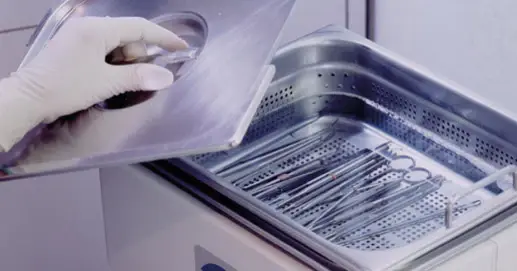
4. Chemical Vapor Sterilizer:
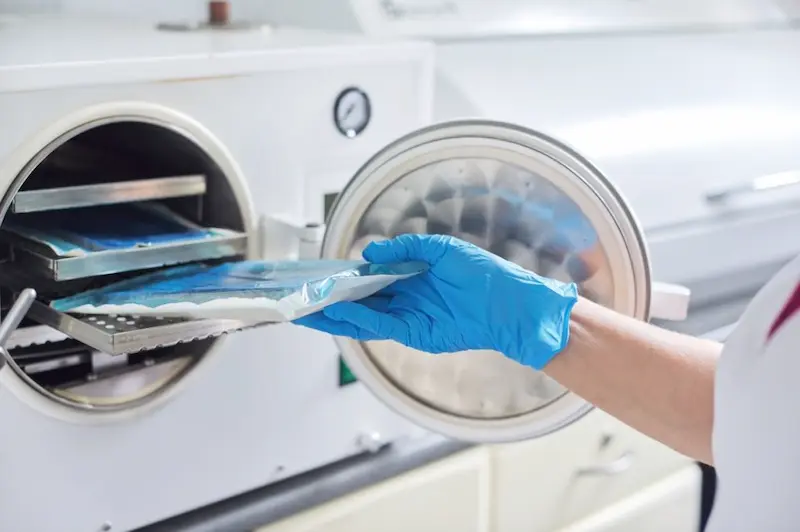
Prioritizing patient safety, our clinic utilizes chemical vapor sterilization, ensuring thorough disinfection of delicate dental instruments without compromising efficacy.
Advantages:
- Gentle on Instruments: Delicate dental tools are preserved, ensuring their longevity and optimal functionality.
- Fast and Efficient: With a quick turnaround time, our instruments are ready promptly, contributing to streamlined workflows and minimizing delays in your dental procedures.
- Reduced Corrosion: The risk of instrument corrosion is minimized. This is beneficial for dental instruments that may be sensitive to corrosive elements.
- Uniform Sterilization: Chemical vapor permeates intricate areas, guaranteeing a thorough disinfection process.
Clinical Area Sanitization:
Dental clinic area sanitization is a critical practice for patients safety. Proper sanitization helps prevent the spread of infections and provides a comfortable atmosphere for dental procedures. Here are key elements of dental clinic area sanitization:
- Surface Disinfection:
- Purpose: Eliminate germs and bacteria from surfaces frequently touched by patients and staff.
- Disinfectants: Use medical-grade disinfectants on countertops, dental chairs, doorknobs, light switches, and other surfaces.
- Treatment Room Cleaning:
- Purpose: Ensure a sterile environment for dental procedures.
- Process: Thoroughly clean and disinfect treatment rooms between patients, paying special attention to dental chairs, trays, and instruments.
- Waiting Area Sanitization:
- Purpose: Minimize the risk of cross-contamination in shared spaces.
- Measures: Regularly clean and disinfect waiting area furniture, magazines, and other frequently touched items.
- Air Filtration and Ventilation:
- Purpose: Improve air quality and reduce the concentration of airborne particles.
- Measures: Use HEPA filters, maintain HVAC systems, and ensure proper ventilation in the clinic.
- Sterilization of Instruments:
- Purpose: Ensure that all dental instruments are free from pathogens.
- Process: Implement rigorous sterilization protocols for dental instruments using autoclaves, chemical vapor sterilizers, or other validated methods.
- Personal Protective Equipment (PPE) Management:
- Purpose: Ensure proper use and disposal of PPE to prevent contamination.
- Measures: Provide designated areas for donning and doffing PPE and proper disposal bins.
- Waste Management:
- Purpose: Proper disposal of medical waste to prevent contamination.
- Measures: Use designated containers for biohazardous waste and adhere to local regulations.
- Staff Training:
- Purpose: Ensure all staff members are educated on proper sanitization procedures.
- Training: Conduct regular training sessions on infection control measures and protocols.
Patient Safety Equipment:
In our dental clinic, we prioritize patient safety through the implementation of advanced safety protocols and the use of cutting-edge equipment and various pieces of equipment contribute to creating a secure and comfortable environment. Here are some essential patient safety equipment you can expect to find in our clinic:
- Protective Eyewear:
- Purpose: Ensuring patients’ eyes are shielded from debris and bright lights during procedures.
- Benefits: Prevents eye injuries and enhances overall comfort during dental treatments.
- Disposable Masks:
- Purpose: Limiting the spread of airborne particles to protect both patients and dental staff.
- Benefits: Reducing the risk of infection and maintaining a hygienic environment.
- Face Shields:
- Purpose: Provide an additional layer of protection for the face against splatter and aerosols.
- Benefits: Enhancing overall facial protection during specific dental procedures.
- Disposable Gloves:
- Purpose: Creating a barrier between dental professionals and patients, minimizing the risk of cross-contamination.
- Benefits: Ensuring a sterile environment and protecting against the transmission of infections.
- High-Volume Evacuation Systems:
- Purpose: Removing saliva, debris, and potentially harmful aerosols during dental procedures.
- Benefits: Enhancing infection control by minimizing the spread of airborne particles.
- Patient Monitoring Equipment:
- Purpose: Monitoring vital signs such as pulse and oxygen saturation during specific dental procedures.
- Benefits: Enhancing patient safety, especially for individuals with underlying health conditions.
- Emergency Response Kit:
- Purpose: Containing essential emergency medications and equipment for a rapid response to unexpected medical events.
- Benefits: Ensuring preparedness for unforeseen medical emergencies in the dental setting.
- Aseptic Techniques and Sterilization Equipment:
- Purpose: Ensuring the proper sterilization of instruments and equipment.
- Benefits: Preventing infections and maintaining a sterile environment for dental procedures.
Our Commitment to Safety:
At IMPLANTOZ, we prioritize the safety of our patients and staff. By investing in advanced sterilization technologies, we aim to provide you with peace of mind, knowing that your oral health is in the hands of a practice dedicated to maintaining the utmost hygiene standards.
For more information about our sterilization practices or to schedule an appointment, please contact us today. Your health and safety are our top priorities.
